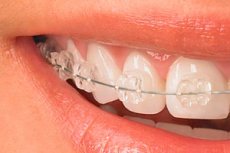Sapphire braces
Last reviewed: 07.06.2024

All iLive content is medically reviewed or fact checked to ensure as much factual accuracy as possible.
We have strict sourcing guidelines and only link to reputable media sites, academic research institutions and, whenever possible, medically peer reviewed studies. Note that the numbers in parentheses ([1], [2], etc.) are clickable links to these studies.
If you feel that any of our content is inaccurate, out-of-date, or otherwise questionable, please select it and press Ctrl + Enter.

To align the teeth and correct the bite, special orthodontic structures are used - plastic, ceramic, sapphire, metal braces. Sapphire braces first appeared in the late 80s of the last century in the United States, they were developed in a division of Johnson & Johnson in the form of a bracket system Starfire System, which became a new trend in orthodontics. [1]
Sapphire and ceramic braces: the difference
Ceramic and sapphire braces are orthodontic designs based on alumina ceramics derived from aluminum oxide (alumina). [2]
Ceramic braces are made of polycrystalline aluminum oxide; they are matte, opaque and whitish in color (very similar to porcelain). The polycrystalline material for them is produced by ceramic injection molding: aluminum oxide particles are mixed with binders and heated under pressure, the resulting thick mixture is poured into molds and baked by heating to a homogeneous mass (without melting). [3]
So-called sapphire braces are made of monocrystalline aluminum oxide - artificial sapphire glass, which is produced industrially from agglomerated aluminum oxide by high-temperature crystallization. The large rod-shaped single crystal produced by this method is milled using ultrasonic cutting or diamond tools.
What do sapphire braces look like? Unlike natural sapphire, a jewel-like blue corundum, "synthetic sapphire" is colorless, then also transparent. And sapphire orthodontic designs are completely transparent and do not stand out against the natural color of tooth enamel. [4]
Advantages and disadvantages of sapphire braces
These are vestibular braces, which means that they are attached to the outside of the teeth. In addition to a more elegant and aesthetic appearance, experts see the advantages of sapphire braces in the fact that - compared to other designs - they are stronger and more securely fixed on the teeth, preventing damage to the enamel. At the same time, the braces squeeze the teeth less than metal braces and are therefore more comfortable. [5]
What are the disadvantages of sapphire braces? If the color of the enamel of the teeth is not perfectly white, then transparent orthodontic structures will contrast against the background of yellowness. Therefore, experts recommend choosing ceramic or metal braces in such cases.
In addition, sapphire braces will have to be worn longer than metal braces, as the process of correcting teeth is longer due to the insufficient pressure of the arch on the jaw.
Doctors do not use sapphire braces for complex cases of crooked teeth and malocclusion. They are mainly used to correct defects in the upper dentition. [6]
Sapphire braces: ligature braces and self-ligating braces
Inspire ice sapphire braces (Ormco, USA) are sapphire ligature braces. Their orthodontic arch is inserted into the grooves of the brackets glued to the surface of the teeth and secured with a special element - ligature, which is put on the wings of the bracket to hold the arch securely. Arcs are made of shape memory metal; they can be gray or white Teflon-coated.
Damon Clear sapphire braces are self-ligating braces in which the metal arch retainer is replaced by a compact, cap-like clamping device. [7]
